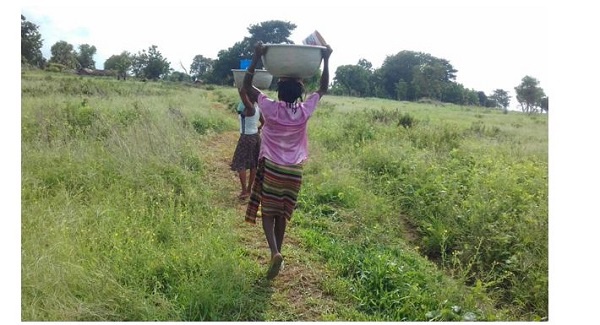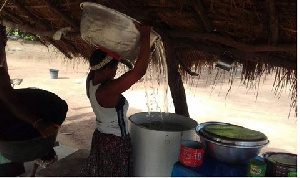Opinions of Saturday, 8 July 2017
Columnist: Gbolu Samson
Drinking to die?
Water, they say, is life. Research shows that water is so essential for human’s existence. According to the World Health Organization and UNICEF, safe drinking-water, sanitation and good hygiene are fundamental to health, survival, growth and development (WHO & UNICEF, 2006).
The drinking-water that is supplied to our homes comes from either surface water or ground water. Surface water could be gotten from, rivers, lakes, and reservoirs.
The main source of drinking-water for a section of Ghana’s population living along the banks of rivers/lakes is surface water – rivers and lakes. Goal 6(1) of the Sustainable Development Goals requires of us that, “by 2030, we achieve universal and equitable access to safe and affordable drinking water for all”.
What deliberate measures are we employing to include these rural folks living in these disadvantaged locations in our quest to achieving universal and equitable access to safe and affordable drinking-water for all? The abundant water they have at their disposal is just not safe for drinking.
They seem to be forgotten in our effort to increasing access to potable water. Meanwhile, according to the World Health Organization and UNICEF’s Progress report on Sanitation and Drinking-water, adequate supply of treated drinking-water is associated with best health outcomes (WHO & UNICEF, 2013).
I doubt, if best health outcomes associated with drinking potable water can be said of Ghanaians living along the banks of rivers/lakes, with respect to their long term dependence on these polluted surface drinking-water sources.
The long-term dependence on polluted surface drinking-water is likely to expose this population along river banks to varied waterborne diseases such as, Salmonella (typhoid), Rotavirus, Polio, Hepatitis A & E, Cryptosporidium, Giardia, Schistosomiasis, Dysentery, E Coli etc. About 130 million infants and children are infected with Rotavirus globally, with 18 million cases of moderate to severe diseases (Griffiths, 2008).
Herd immunity required to eliminate susceptibility to Polio and Rotavirus through childhood vaccination among children in these communities cannot be guaranteed.
These are communities which are on scattered islands and are virtually hard-to-reach, contributing to a chunk of the children missing out on the Expanded Programme on Immunization. Children in these communities in Ghana could still be at risk for Rotavirus and Polio, even though Rotavirus and Polio are both vaccine preventable diseases.

Sustainable Development Goal 3(3.3) entreats us to, “end water-borne diseases among other things by 2030”. Studies have also established association with consumption of polluted water and stunted growth and cognitive impairment among children (Griffiths, 2008).
Every year, unsafe water, coupled with lack of basic sanitation, kills at least 1.6 million children under the age of five years – more than eight times the number of people who died in the Asian tsunami of 2004 (WHO & UNICEF, 2006).
Communities along banks of these rivers and Lake also engage in all forms of farming practices which contribute in various ways to polluting these rivers. They farm at the banks, just inches away from the river with the application of all manner of chemicals – herbicides, pesticides etc., right from preparation of the land to the period of harvest.
Sustainable Development Goal 3(3): requires us to, “sustainably reduce the number of deaths and illness from hazardous chemicals and air, water and soil pollution and contamination by 2030”.
It is obvious that when it rains, these chemicals being applied on these farms are easily washed into the river. Erosion of these chemicals and other pollutants into the river/Lake becomes easy because of the topography of the land at the banks.
Virtually every material [mostly pollutants] on the land close to the river are also washed directly into the river even with minimal amount of rainfall.
 Women fetching water from the Sene River
Women fetching water from the Sene River
Most of these communities and households along these rivers/Lake have no toilet facilities. They resort to the practice of open defecation, close to the rivers/Lake, polluting them, especially during the rainy season. It’s also common to see faecal matter of domestic animals, sanitary pads etc. floating on the surfaces of these rivers/Lake.
This is what Sustainable Development Goal 6(2) got to say on the above phenomenon: “by 2030, achieve access to adequate and equitable sanitation and hygiene for all, and end open defecation, paying special attention to the needs of women and girls and those in vulnerable situations”.
Other human activities which contribute to pollution of the rivers/Lake are but not limited to, bathing in the river, washing in it, direct defecation into the river, the use of poisons for fishing etc.
Haven spoken to a section of residents from different communities, there was a common admission that some community members also do take delight in defecating into the rivers/Lake. Perpetrators of this hazardous health behaviour are usually some fishermen.
They do this when they go fishing at the deeper ends of the river/Lake. Some users of the Lake for transportation have also been accused of engaging in this act of direct defecation into the river, when they travel with their boats especially at night. What is the position of the SDGs on this?
The stand of Sustainable Development Goal 6(3) is that, “by 2030, improve water quality by reducing pollution, eliminating dumping and minimizing release of hazardous chemicals and materials, halving the proportion of untreated wastewater ……”.

Growing up as a young boy, and per the nature of my job as rural-community preventive health advocate, I have had the opportunity to live part of my life in some of these communities, and really do appreciate the level of sources of drinking-water pollution in these areas.
And I have no doubt that our folks who live along our river banks, who are equally Ghanaians with equal rights to basic amenities like potable water, are not drinking to live, but are drinking to die.
The only cost-free and readily available option is for these people to boil their drinking-water before drinking, but it appears this is a health behaviour change they find very difficult to adopt.
I am with the conviction that if only governments in Africa could show a little commitment to all the 17 SDGs and begin to align their policies with these Goals, our continent – Africa, will do just fine.
Access to potable water by a nation’s population is key to decreasing the incidence of diseases. Hence, if we, and government are committed to reducing the disease burden in Ghana, let’s make deliberate efforts by increasing access to potable water for the citizenry, especially the marginalized in our hard-to-reach communities.
Entertainment










